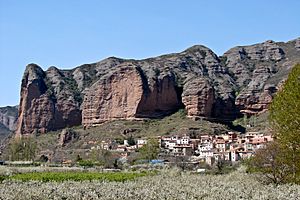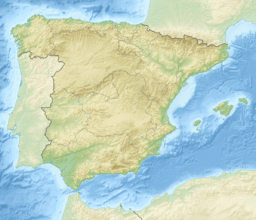Peña Bajenza facts for kids
Quick facts for kids Peña Bajenza |
|
|---|---|
| "Gate of La Rioja", "Mountains of Islallana", "Rocks of Viguera" | |

Peña Bajenza with the village of Islallana below
|
|
| Highest point | |
| Elevation | 941 m (3,087 ft) |
| Prominence | 763 m (2,503 ft) |
| Geography | |
| Location | La Rioja, |
| Parent range | Peñas de Viguera |
| Geology | |
| Mountain type | Rock formation |
| Climbing | |
| First ascent | No date |
| Easiest route | From Islallana (4,000 meters) |
Peña Bajenza is a huge rock formation in La Rioja, Spain. It's also known by cool names like "Gate of La Rioja" or "Mountains of Islallana." This amazing natural landmark stands right above the village of Islallana, which is part of Nalda.
The rocks are about 400 meters (1,300 feet) tall and have a reddish color. They were shaped over many years by erosion, which is when wind and water slowly wear away the rock. Peña Bajenza is part of the Peñas de Viguera mountain range and is one of the most famous sights in the area.
This rock formation is a popular spot for hiking and climbing. It's also home to many wild birds, including large griffon vultures and Egyptian vultures, especially in the summer. You'll see two big crosses on the mountain. The first one is at the start of the trail, about 475 meters (1,558 feet) above sea level. The second, more famous cross is at the very top of the highest rock, at 941 meters (3,087 feet) above sea level. Every year on May 3, people make a special trip, called the Romería de la Cruz, to the top of Peña Bajenza.
Contents
Exploring Peña Bajenza: Hiking Trails
There are many ways to reach Peña Bajenza, but the most popular path starts in Islallana.
The Main Trail to the Top
This trail begins by crossing the Iregua river on a paved path. After the river, the path turns into a dirt trail, and you'll start to go uphill. Soon, you'll see the first cross at the base of the mountain. From there, the path becomes steeper, leading you through a pine forest. You might even spot some water pipes that show the quickest way up! Following the clear signs, you'll climb to the very top of the mountain. Once you've enjoyed the summit, this trail leads you back down to Islallana. This round trip usually takes about 2 and a half hours and covers about 8.45 kilometers (5.25 miles).
The Longer Pilgrim's Route
Another common route, especially for pilgrims, is similar to the first one at the start. However, instead of returning to Islallana, this path continues southwest. You'll always choose the left turn at any cross on the trail. On this longer journey, you will find the Hermitage of San Marcos. After passing through a valley and several hills, the path takes you directly to Castillo de Viguera mountain. The climb here is not too difficult, even if the rocks are a bit wet. The route finishes by heading northeast to the village of Viguera. To get back to Islallana, you can take the road that connects Viguera and Islallana. This longer adventure takes about 5 hours and covers 18.26 kilometers (11.35 miles).
Amazing Views from the Top
The views from the top of Peña Bajenza are truly some of the most beautiful in all of La Rioja. From up high, you can see many different villages and even the main city of the province, Logroño. If you don't like heights, be careful, as the views are very high up!
You can see most of the Iregua river winding through the landscape, especially along the road that connects Soria and Logroño. Just below the almost vertical rock face is the village of Islallana, which is about 300 meters (984 feet) below the summit.
Looking around, you can spot many other landmarks and towns:
- To the northwest, you'll see Moncalvillo and Peña Moya.
- To the southwest, you can see the Castle of Viguera, which is a high point on one of the popular hiking routes.
- To the east, you'll find Rodalillo, Arnedo, and Peña Aldera.
- To the west, you can see Nalda, Albelda de Iregua, and Logroño.
Traditions and Fun Times
Peña Bajenza is a special place for local traditions and family fun.
- The Romería de la Cruz: Every year on May 3, people make a pilgrimage to the top of the rock formation. Many parents bring their young children along for this special trip. It's a tradition for people from the area to go to the top at least once in their lives, either as children with their families or later with their friends.
- Summer Adventures: Summer is a very popular time to visit Peña Bajenza. Many families from nearby areas spend a day hiking up the mountain with their children. While it can be a bit challenging, many people say it's better to go on days when it's not too sunny to avoid getting too hot.
- Friends' Day Out: Groups of young people also love to climb Peña Bajenza just to have a great time together. They often start very early in the morning, enjoy lunch and take photos at the top, and then head back down in the afternoon to their villages.
See also
 In Spanish: Peña Bajenza para niños
In Spanish: Peña Bajenza para niños



